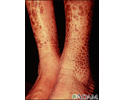Lamellar ichthyosis
LI; Collodion baby - lamellar ichthyosis; Ichthyosis congenital; Autosomal recessive congenital ichthyosis - lamellar ichthyosis type
Lamellar ichthyosis (LI) is a rare skin condition. It appears at birth and continues throughout life.
Causes
LI is an autosomal recessive disease. This means that the mother and father must both pass one variant copy of the disease gene to their child in order for the child to develop the disease.
Symptoms
Many babies with LI are born with a clear, shiny, waxy layer of skin called a collodion membrane. For this reason, these babies are known as collodion babies. The membrane sheds within the first 2 weeks of life. The skin underneath the membrane is red and scaly resembling the surface of a fish.
With LI, the outer layer of skin called the epidermis cannot protect the body like the healthy epidermis can. As a result, a baby with LI may have the following health problems:
- Difficulty in feeding
- Loss of fluid (dehydration)
- Loss of balance of minerals in the body (electrolyte imbalance)
- Breathing problems
- Body temperature that is not stable
- Skin or body-wide infections
Older children and adults with LI may have these symptoms:
- Giant scales that cover most of the body
- Decreased ability to sweat, causing sensitivity to heat
- Hair loss
- Abnormal finger and toenails
- Skin of the palms and soles is thickened
Treatment
Collodion babies usually need to stay in the neonatal intensive care unit (NICU). They are placed in a high-humidity incubator. They will need extra feedings. Moisturizers need to be applied to the skin. After the collodion membrane is shed, babies can usually go home.
Lifelong care of the skin involves keeping the skin moist to minimize the thickness of the scales. Measures include:
- Moisturizers applied to the skin
- Medicines called retinoids that are taken by mouth in severe cases
- High-humidity environment
- Bathing to loosen scales
Possible Complications
Babies are at risk for infection when they shed the collodion membrane.
Eye problems may occur later in life because the eyes cannot close completely.
References
Martin KL. Disorders of keratinization. In: Kliegman RM, St. Geme JW, Blum NJ, et al, eds. Nelson Textbook of Pediatrics. 22nd ed. Philadelphia, PA: Elsevier; 2025:chap 699.
Moon M, Guerrero AM, Li Xiaoxiao, Koch E, Gehris RP. Dermatology. In: Zitelli BJ, McIntire SC, Nowalk AJ, Garrison J, eds. Zitelli and Davis' Atlas of Pediatric Physical Diagnosis. 8th ed. Philadelphia, PA: Elsevier; 2023:chap 8.
Patterson JW. Disorders of epidermal maturation and keratinization. In: Patterson JW, ed. Weedon's Skin Pathology. 5th ed. Philadelphia, PA: Elsevier; 2021:chap 10.
Richard G. Ichthyoses, erythrokeratodermas, and related disorders. In: Bolognia JL, Schaffer JV, Cerroni L, eds. Dermatology. 5th ed. Philadelphia, PA: Elsevier; 2025:chap 57.
Review Date: 10/13/2024





